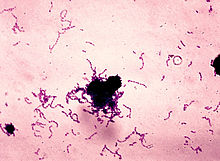| Streptococcus mutans | |
|---|---|

| |
| Stain of S. mutans in thioglycolate broth culture. | |
| Scientific classification | |
| Domain: | Bacteria |
| Phylum: | Bacillota |
| Class: | Bacilli |
| Order: | Lactobacillales |
| Family: | Streptococcaceae |
| Genus: | Streptococcus |
| Species: | S. mutans
|
| Binomial name | |
| Streptococcus mutans Clarke 1924
| |
Streptococcus mutans is a facultatively anaerobic, gram-positive coccus (round bacterium) commonly found in the human oral cavity and is a significant contributor to tooth decay.[1][2] The microbe was first described by James Kilian Clarke in 1924.[3]
This bacterium, along with the closely related species Streptococcus sobrinus, can cohabit the mouth: Both contribute to oral disease, and the expense of differentiating them in laboratory testing is often not clinically necessary. Therefore, for clinical purposes they are often considered together as a group, called the mutans streptococci.[4] This grouping of similar bacteria with similar tropism can also be seen in the viridans streptococci – which Streptococcus mutans is itself also a member of.[5]
- ^ Ryan KJ, Ray CG, eds. (2004). Sherris Medical Microbiology (4th ed.). McGraw Hill. ISBN 978-0-8385-8529-0.[page needed]
- ^ Loesche WJ (1996). "Ch. 99: Microbiology of Dental Decay and Periodontal Disease". In Baron S (ed.). Baron's Medical Microbiology (4th ed.). University of Texas Medical Branch. ISBN 978-0-9631172-1-2. PMID 21413316.
- ^ Thomas VJ, Rose FD (1924). "Ethnic differences in the experience of pain". Social Science & Medicine. 32 (9): 1063–6. doi:10.1016/0277-9536(91)90164-8. PMC 2047899. PMID 2047899.
- ^ Newcastle University Dental School. "Streptococcus mutans and the mutans streptococci. In: The Oral Environment, online tutorial". Archived from the original on 2013-11-05. Retrieved 2013-11-04.
- ^ English BK, Shenep JL (2009). "ENTEROCOCCAL AND VIRIDANS STREPTOCOCCAL INFECTIONS". Feigin and Cherry's Textbook of Pediatric Infectious Diseases. Elsevier. p. 1258–1288. doi:10.1016/b978-1-4160-4044-6.50100-x. ISBN 978-1-4160-4044-6.